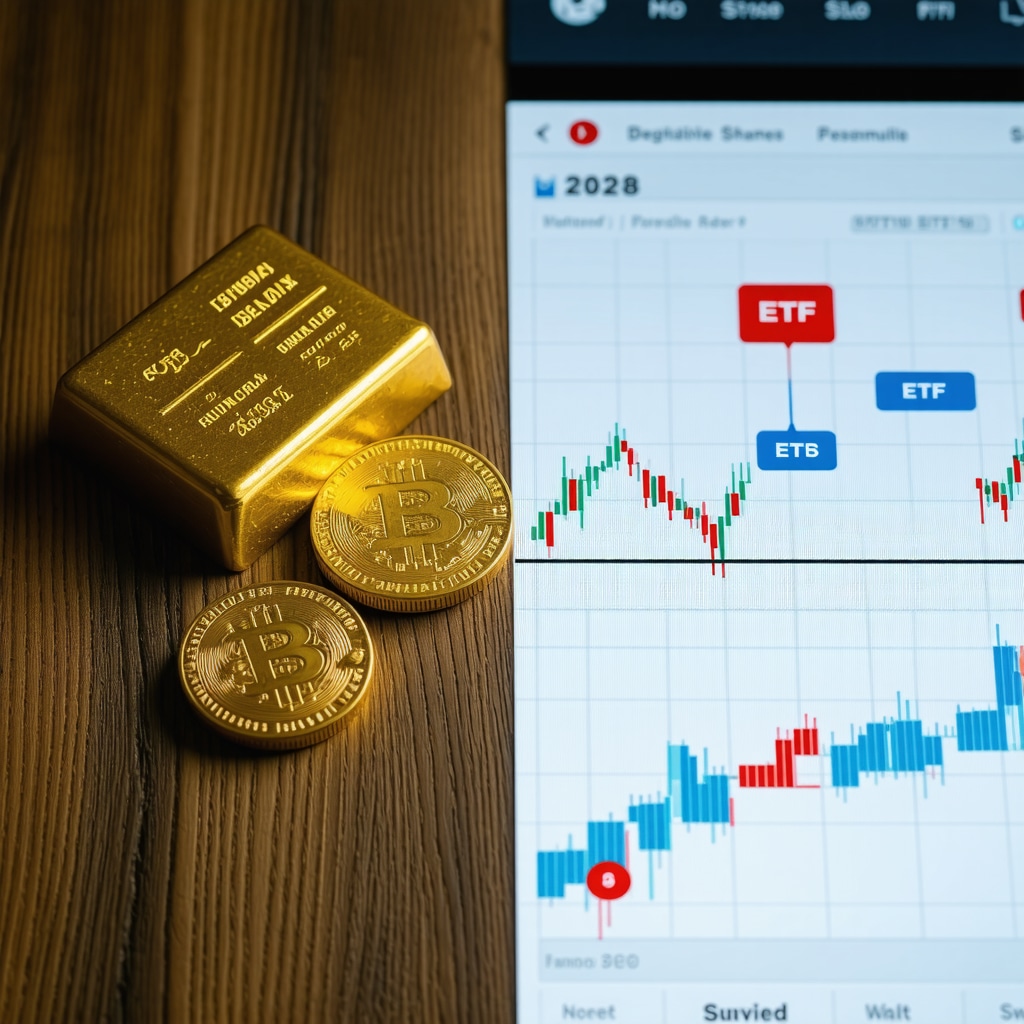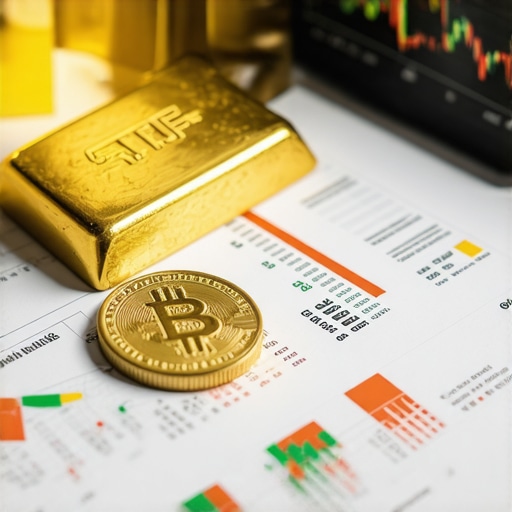Unlocking the Golden Dilemma: Physical Gold or ETFs in 2028?
As we stride deeper into 2028, investors face a pivotal question: should they anchor their portfolios in tangible gold bullion or embrace the digital ease of gold ETFs? Each investment avenue offers distinct advantages and subtle pitfalls, making the choice far more nuanced than a simple preference. This exploration dives into these two dominant gold investment forms, revealing insights shaped by evolving market dynamics, technological advances, and economic forecasts.
Why Physical Gold Remains the Timeless Guardian of Wealth
Physical gold, encompassing coins, bars, and bullion, carries an irreplaceable allure — its tactile presence symbolizes security and tangible wealth. Investors often treasure this form for protection against currency devaluation and geopolitical uncertainties. In 2028, physical gold continues to shine as a hedge against inflation and a safe haven during market turbulence. However, owning physical gold requires careful considerations regarding storage costs, insurance, and liquidity constraints.
For example, seasoned investors diversify their holdings by combining well-known bullion coins like the American Gold Eagle or Canadian Maple Leaf, which are globally recognized and easy to trade. Practical experience shows that secure vault storage and verified dealers mitigate risks associated with counterfeit products and theft. For detailed guidance on selecting and safeguarding physical gold, see our Physical Gold Investment Tips for Maximizing Security and Value.
The Rise of Gold ETFs: Digital Simplicity Meets Market Agility
Gold Exchange-Traded Funds (ETFs) have transformed gold investing by offering liquidity, accessibility, and cost-efficiency unmatched by physical holdings. In 2028, ETFs appeal particularly to investors seeking portfolio diversification without the logistical burdens of physical gold. By purchasing shares that track gold prices, investors gain exposure to the metal’s performance with ease of trading on stock exchanges.
However, ETFs introduce counterparty risks and management fees that can erode returns over time. Unlike physical gold, ETFs do not grant possession of the metal itself, which may concern purists prioritizing tangible assets. Yet, for many, the ability to swiftly adjust positions and integrate gold exposure into broader investment strategies makes ETFs indispensable. For a comprehensive look at top-performing options, explore Best Gold ETFs for Portfolio Diversification in 2027.
How Do Gold ETFs and Physical Gold Compare in Terms of Long-Term Stability?
When assessing long-term stability, physical gold offers unmatched intrinsic value and resilience, often retaining worth through economic downturns and inflationary spikes. Conversely, gold ETFs provide flexibility and potential for enhanced returns through portfolio synergies but are susceptible to market volatility and regulatory changes. Expert analyses from the World Gold Council emphasize that a balanced approach, combining both investment types, can optimize risk-adjusted returns while preserving liquidity and security (World Gold Council Research).
Personalized Investment Strategies: Aligning Gold Types with Your Financial Goals
Choosing between physical gold and ETFs in 2028 hinges on individual investment objectives, risk tolerance, and market outlook. For those prioritizing wealth preservation and tangible security, physical gold backed by reputable dealers remains superior. Conversely, investors seeking growth, convenience, and integration with diversified portfolios may find gold ETFs more fitting.
Moreover, savvy investors often incorporate gold IRAs to enhance retirement security through gold exposure. For actionable steps on this front, our guide on How to Start a Gold IRA: Step-by-Step Guide for Beginners is invaluable.
Engage with us: Have you experienced success or challenges investing in physical gold or ETFs? Share your insights and questions in the comments below to enrich this ongoing conversation about mastering gold investments in 2028.
Balancing Act: How I Blend Physical Gold and ETFs for a Resilient Portfolio
As someone who has walked the path of gold investing through various market cycles, I’ve found that neither physical gold nor ETFs alone provide the full picture for a robust portfolio. Early on, I leaned heavily toward physical gold, captivated by its tangible nature and historical reliability. Yet, as markets evolved, I noticed how ETFs offered seamless access and agility that physical holdings simply couldn’t match.
Today, my strategy involves a thoughtful blend—allocating a core portion of my wealth to physical gold bars and coins, while using ETFs to tactically adjust exposure amid market shifts. This dual approach provides peace of mind through the tangibility of bullion and the flexibility of ETFs, especially during volatile periods. Of course, this requires ongoing education and vigilance to balance costs, risks, and benefits effectively.
Practical Lessons from Storing and Insuring Physical Gold
One aspect often underestimated by new investors is the responsibility that comes with owning physical gold. When I first started, I kept my gold in a home safe. It felt secure until I realized the limitations: insurance premiums skyrocketed, and liquidity was hampered by the need to physically move and verify assets during transactions.
Switching to professional vault storage was a game-changer. Not only did it provide enhanced security and insurance coverage, but it also simplified the process of selling or leveraging my gold holdings. If you’re considering physical gold, I highly recommend looking into secure vault options and understanding the associated fees. This approach aligns well with the advice shared in our Quick Guide to Physical Gold Storage and Security Tips.
What Are the Hidden Costs and Risks We Often Overlook in Gold Investing?
This question often pops up in conversations among friends and fellow investors. Beyond the obvious purchase price and brokerage fees, there are subtle but impactful costs to consider. For physical gold, these include storage fees, insurance, and potential liquidity constraints during urgent sales. For ETFs, management expenses, tracking errors, and counterparty risks quietly chip away at returns over time.
Understanding these nuances helped me avoid common pitfalls and tailor my investment approach. For instance, while ETFs offer convenience, I remain cautious about relying solely on them during economic uncertainty, where physical gold’s tangibility shines. Balancing these factors informed by personal experience and expert insights, such as those from the World Gold Council, has been invaluable in shaping a resilient portfolio.
Integrating Gold Investments with Broader Financial Plans
Gold, whether physical or ETF-based, shouldn’t exist in isolation within your portfolio. I’ve found integrating gold investments with other asset classes—stocks, bonds, real estate—creates a more stable and growth-oriented financial plan. Gold acts as a counterbalance during stock market dips and inflationary periods.
For those looking to secure retirement through gold, setting up a gold IRA is a powerful strategy. I walked through the process myself and documented every step in our How to Start a Gold IRA: Step-by-Step Guide for Beginners. This resource demystifies complexities and helps investors confidently harness gold’s protective qualities for their golden years.
I’d love to hear your experiences: Have you navigated the balance between physical gold and ETFs? What challenges or successes have you encountered? Share your stories and questions below—let’s build a community that learns and grows together in this golden journey.
Mastering the Tax Landscape: Navigating Complexities of Gold Investment Taxation in 2028
Investment in gold, whether physical bullion or ETFs, intersects intricately with tax regulations that vary significantly by jurisdiction and investment vehicle. In 2028, understanding these tax nuances is imperative for maximizing after-tax returns and avoiding unexpected liabilities. Physical gold, classified as a collectible asset by the IRS in the United States, attracts a higher capital gains tax rate capped at 28%, compared to the standard long-term capital gains rate for securities. This distinction profoundly affects the net profitability of bullion sales.
Conversely, gold ETFs often benefit from more favorable tax treatment, being classified similarly to equity securities, thus subject to standard long-term capital gains rates, which in many cases are lower than those for collectibles. However, tax implications can become more complex with ETFs that hold physical gold versus those that track gold futures or indexes, often involving different reporting and withholding requirements.
International investors must also navigate cross-border tax treaties and reporting standards such as FATCA and CRS, which can impact the reporting obligations and withholding taxes on gold investment returns. Investors would be wise to consult tax professionals who specialize in precious metals and international taxation to structure their portfolios efficiently.
How Can Investors Optimize Tax Efficiency When Balancing Physical Gold and ETFs?
Optimizing tax efficiency in gold investing requires a strategic approach. Many experts recommend utilizing tax-advantaged accounts such as IRAs or self-directed retirement accounts to hold physical gold, thereby deferring taxes until withdrawal. For ETFs, investors might employ tax-loss harvesting techniques to offset gains and strategically time sales to benefit from long-term capital gains rates.
Moreover, understanding the nuances of wash sale rules and their applicability—or lack thereof—to physical gold versus ETFs can prevent inadvertent disqualifications of tax benefits. Sophisticated investors may also consider layering their gold holdings across taxable and tax-advantaged accounts to balance liquidity needs and tax obligations.
For comprehensive tax strategies tailored to gold investments, the IRS Topic No. 409 – Capital Gains and Losses offers authoritative guidance, while consultation with a CPA specializing in precious metals is highly advisable.
Harnessing Advanced Hedging Techniques: Mitigating Gold Market Volatility in a Post-Pandemic Economy
The gold market in 2028 remains influenced by multifaceted forces including geopolitical tensions, inflationary pressures, and evolving monetary policies. These factors contribute to price volatility, challenging investors to protect their portfolios against downside risks. Advanced hedging strategies have thus become essential tools.
One sophisticated approach involves using options contracts on gold ETFs or futures to lock in price floors or ceilings, thereby managing downside exposure without liquidating physical assets. Additionally, pairing gold investments with correlated assets such as inflation-protected securities or currency hedges can further stabilize portfolio returns.
Dynamic allocation models that adjust gold exposure based on macroeconomic indicators and technical analysis signals offer another layer of protection and opportunity. These models often rely on algorithmic trading systems incorporating artificial intelligence to optimize timing and scale of gold transactions.
Engaging with these strategies requires deep market knowledge and risk management expertise. Investors should consider leveraging professional advisory services or advanced trading platforms that provide access to derivatives and real-time analytics.
What Role Does Artificial Intelligence Play in Enhancing Gold Investment Decisions?
Artificial intelligence (AI) is increasingly pivotal in deciphering complex market signals and enhancing decision-making processes for gold investors. AI-driven predictive models analyze vast datasets, including macroeconomic indicators, geopolitical events, social sentiment, and historical price patterns to forecast gold price movements with higher precision.
These technologies enable investors to implement algorithmic trading strategies that can dynamically adjust portfolio allocations between physical gold and ETFs based on real-time risk assessments and market conditions. Moreover, AI can aid in identifying arbitrage opportunities and optimizing tax-loss harvesting strategies.
As AI continues to evolve, its integration into gold investment platforms promises to democratize access to sophisticated tools previously reserved for institutional investors, empowering retail investors to make more informed, timely decisions.
Explore More: For those interested in leveraging AI tools for gold investing, our upcoming webinar series will delve into practical applications and platform demonstrations. Stay tuned and sign up to elevate your investment acumen in this rapidly advancing landscape.
Strategic Tax Maneuvers: Elevating Gold Investment Profitability Beyond Basics
In the intricate labyrinth of gold investment taxation, mastering advanced strategies can transform modest gains into substantial wealth preservation. Beyond conventional advice, savvy investors leverage mechanisms such as tax deferral through precious metals IRAs, tactical asset location, and exploiting nuanced differences in tax treatment between physical gold and ETFs. Strategic timing of asset disposals aligned with fiscal year-end projections further amplifies after-tax returns.
Moreover, understanding jurisdiction-specific tax credits and exemptions can unlock additional efficiencies. For instance, some international investors benefit from treaties that mitigate withholding taxes on dividends or distributions linked to gold ETFs, thereby enhancing net yields. Sophisticated portfolio architects also integrate tax-efficient charitable giving of gold assets, optimizing both philanthropic goals and tax liabilities.
How Can Advanced Tax Planning Techniques Minimize Gold Investment Liabilities Without Compromising Liquidity?
Addressing this question requires a multi-layered approach. Investors might employ a split-hold strategy—allocating physical gold to tax-advantaged accounts to defer or reduce taxes while maintaining ETFs in taxable accounts to capitalize on lower capital gains rates and liquidity. Employing tax-loss harvesting on ETFs during market downturns can offset gains realized from physical gold sales, effectively reducing overall tax burden.
Furthermore, engaging in periodic portfolio rebalancing timed with tax calendar insights ensures that tax implications are optimized without sacrificing portfolio agility. Utilizing 1031 exchanges where applicable or their international equivalents can defer recognition of gains, preserving capital for reinvestment. Such sophisticated planning mandates collaboration with tax professionals attuned to precious metals nuances.
For authoritative guidance on these intricate tax strategies, the Tax Policy Center’s briefing on capital gains taxation provides comprehensive insight into optimizing capital gains management.
Leveraging Artificial Intelligence: A Quantum Leap in Gold Market Hedging and Forecasting
The advent of AI-powered analytics has revolutionized the landscape of gold investment, offering unprecedented precision in volatility forecasting and risk mitigation. Cutting-edge machine learning models ingest diverse data streams—from macroeconomic indicators and geopolitical sentiment to high-frequency trading signals—distilling actionable intelligence that traditional analysis methods cannot match.
Investors now deploy AI to construct adaptive hedging frameworks that dynamically recalibrate exposure between physical gold and ETFs in response to evolving market conditions. This agility not only cushions portfolios against abrupt shocks but also exploits transient arbitrage opportunities across global gold markets.
Additionally, neural networks enhance scenario analysis, simulating complex economic shifts and their probable impact on gold prices, enabling preemptive strategy adjustments. The synergy of AI with blockchain-based asset tracking further enhances transparency and trust in gold trading, reducing counterparty risks inherent in digital gold products.
What Are the Practical Steps for Investors to Implement AI-Driven Gold Investment Strategies Effectively?
Implementing AI solutions demands both technological infrastructure and domain expertise. Investors should start by selecting platforms that integrate robust AI analytics tailored to precious metals markets, ensuring access to real-time data feeds and customizable alert systems. Partnering with fintech firms specializing in AI-driven wealth management can bridge knowledge gaps.
Education is paramount—investors must comprehend algorithmic outputs and maintain human oversight to interpret AI recommendations contextually. Backtesting strategies using historical data helps validate AI models before live deployment, mitigating unforeseen risks.
For a deeper dive into practical AI applications in gold investing, the Investopedia article on AI in finance offers an expert-level primer that blends theoretical foundations with actionable advice.
Unlock the future of gold investing: Engage with our specialized AI-driven investment tools and tax strategy consultations today, and stay ahead in the ever-evolving gold market landscape by subscribing to our advanced insights newsletter.
Frequently Asked Questions (FAQ)
What are the primary differences between physical gold and gold ETFs?
Physical gold represents tangible assets like coins and bars that you own outright, offering intrinsic value and direct control. Gold ETFs are financial instruments that track gold prices, traded on stock exchanges, providing liquidity and ease of access but without physical possession. Each carries unique benefits and risks related to storage, liquidity, taxation, and counterparty exposure.
How does storage impact the cost-effectiveness of owning physical gold?
Storage of physical gold involves secure vault fees, insurance, and sometimes transport costs, which can erode returns over time. Proper storage mitigates risks like theft and damage but adds ongoing expenses. Selecting reputable vault providers and understanding their fee structures is essential to balance security with cost efficiency.
Are gold ETFs suitable for long-term wealth preservation compared to physical gold?
Gold ETFs offer portfolio flexibility and lower transactional friction, making them attractive for diversified strategies. However, physical gold historically retains intrinsic value better during severe economic crises and currency devaluations. A hybrid approach often optimizes both liquidity and stability in long-term wealth preservation.
What tax considerations should investors be aware of when choosing between physical gold and ETFs?
Physical gold is usually taxed as a collectible asset (e.g., 28% maximum capital gains in the U.S.), while gold ETFs often enjoy standard equity capital gains rates, which can be lower. Tax efficiency can be enhanced by holding gold assets in tax-advantaged accounts and employing strategies like tax-loss harvesting. Consulting with tax professionals familiar with precious metals is advisable.
How can artificial intelligence improve gold investment strategies?
AI enables analysis of complex datasets including geopolitical events, market sentiment, and economic indicators to forecast gold price movements more precisely. It supports dynamic portfolio rebalancing, risk management via options and futures, and identification of arbitrage opportunities. Investors can leverage AI-driven platforms for enhanced decision-making but should maintain human oversight.
What are advanced hedging techniques to manage gold market volatility?
Techniques include using options contracts to set price floors or ceilings, pairing gold with inflation-protected securities and currency hedges, and applying algorithmic trading models that adjust exposure based on macroeconomic signals. These approaches help mitigate downside risk and capitalize on market fluctuations effectively.
Is it advisable to combine physical gold and ETFs in a single portfolio?
Yes, combining both can provide a balanced portfolio blending the tangibility and security of physical gold with the liquidity and convenience of ETFs. This diversification helps manage risks, optimize returns, and adapt to varying market conditions and personal investment goals.
How do international tax treaties affect gold investments?
Cross-border investors must navigate tax treaties that can reduce withholding taxes and reporting burdens. Compliance with regulations like FATCA and CRS is crucial. Understanding these treaties helps optimize after-tax returns and ensure lawful reporting.
What are common pitfalls new gold investors should avoid?
Common pitfalls include underestimating storage and insurance costs for physical gold, overlooking counterparty risks in ETFs, ignoring tax implications, and lacking diversification. Education, due diligence, and consulting experts improve outcomes and safeguard investments.
How does a Gold IRA work, and what benefits does it offer?
A Gold IRA is a self-directed retirement account that holds physical gold or gold-related assets, providing tax advantages such as deferred taxes on gains. It helps investors protect retirement savings from market volatility and inflation. Setting one up requires compliance with IRS rules and working with custodians specializing in precious metals.
Trusted External Sources
- World Gold Council (https://www.gold.org): This authoritative body provides comprehensive research on gold investment vehicles, market trends, and the metal’s role in financial portfolios, offering invaluable data for strategic decision-making.
- Internal Revenue Service (IRS) – Topic No. 409 (https://www.irs.gov/taxtopics/tc409): Essential for understanding U.S. tax regulations on capital gains and losses related to gold investments, including distinctions between physical gold and ETFs, guiding tax-efficient planning.
- Tax Policy Center (https://www.taxpolicycenter.org): Offers in-depth analysis of capital gains taxation and advanced tax planning strategies, crucial for optimizing after-tax returns in gold investing.
- Investopedia – Artificial Intelligence in Finance (https://www.investopedia.com/artificial-intelligence-in-finance-5188753): Provides expert insights on applying AI to financial markets, including predictive analytics and algorithmic trading relevant to gold investment strategies.
- SEC EDGAR Database (https://www.sec.gov/edgar.shtml): For detailed filings and disclosures of gold ETFs, enabling investors to evaluate management fees, holdings, and regulatory compliance for informed choices.
Conclusion
In the evolving landscape of 2028, investing in gold demands a nuanced understanding of the distinctions and synergies between physical gold and gold ETFs. Physical gold offers timeless security and intrinsic value, ideal for wealth preservation amid uncertainty, while gold ETFs provide unparalleled liquidity, cost efficiency, and integration within diversified portfolios.
Tax implications, storage considerations, and emerging technologies like artificial intelligence further shape the investment calculus, underscoring the importance of sophisticated strategies and professional guidance. Embracing a balanced approach that leverages the strengths of both physical bullion and ETFs can empower investors to optimize returns, manage risks, and secure financial resilience.
We invite you to apply these expert insights to your investment journey. Share your experiences, ask questions, and explore our related expert content to deepen your mastery of gold investing in 2028 and beyond.











This post offers a comprehensive overview of the ongoing debate between physical gold and ETFs in 2028. Having invested in both over the years, I agree that diversifying between the tangible and the digital can provide a solid risk management strategy, especially given the different tax implications and storage costs involved.
One challenge I faced with physical gold was the insurance and storage fees, which initially caught me off guard. Once I moved to professional vault storage, it became much more manageable, but I wonder how others balance these costs with their overall portfolio goals?
Regarding ETFs, I’ve found them to be incredibly flexible for quick adjustments, but I remain cautious about counterparty risks during volatile markets. Have any of you explored combining both assets with specific allocation strategies to optimize long-term stability and growth in today’s economic climate? Would love to hear your insights or any tips on maintaining that balance effectively.
This comparison between physical gold and ETFs really hits the mark for 2028, especially as market conditions become more complex. I’ve personally found that part of successful gold investing is understanding the role of costs—like storage fees for physical gold—and how they eat into long-term gains. Transitioning to professional vaults definitely helped mitigate risks, though the fees can be significant if not carefully managed.
On the ETF side, it’s hard to ignore the convenience, but I’ve always wondered about the implications of counterparty risk—especially during economic downturns when some ETFs might face liquidity issues. Has anyone explored specific allocation strategies that balance physical gold’s stability with the agility of ETFs?
Also, with recent advancements in AI-driven analytics, I’m curious if more investors are using technology to optimize these balances automatically. How are others leveraging tech tools to enhance their portfolios? Would love to hear some innovative approaches or insights on managing these two assets effectively in such a dynamic environment.